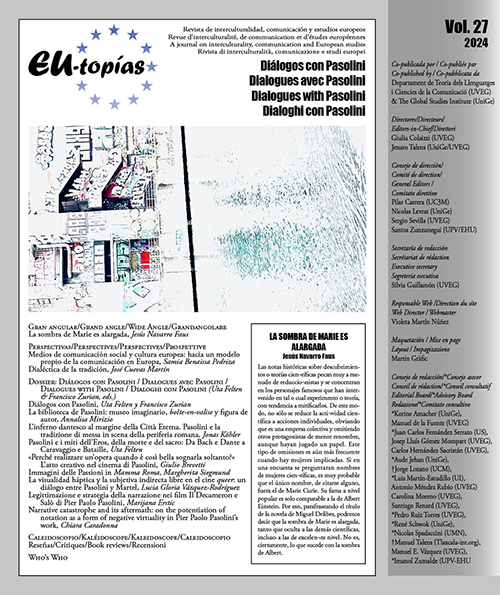Dante’s inferno on the margins of the Eternal City. Pasolini and the staging tradition of the Roman periphery
DOI:
https://doi.org/10.7203/eutopias.27.28416Keywords:
Pasolini, Accattone, Mamma Roma, Lo chiamavano Jeeg Robot, Non essere cattivo, Come un gatto in tangenziale, Roman periphery, Italian cinema. Abstract
Abstract
This paper will discuss the dialogue between Pasolini and a new generation of Italian filmmakers, in particular a specific tradition of staging the city, not failing to explore the use and partial deconstruction of myths associated with Rome, and the associated stylistics of a particular narrative, which began thanks to the cinematic work of Pasolini. In this context, the dialogue between Pasolini’s films Accattone (1961) and Mamma Roma (1962) and three films of the last decade will be analyzed: Gabriele Mainetti’s Lo chiamavano Jeeg Robot (2015), Claudio Caligari’s Non essere cattivo (2015), and Riccardo Milani’s Come un gatto in tangenziale (2017).
 Downloads
Downloads
 References
References
Andraschik, Franziska. “La nostalgia del sacro“ – Die Poetik von Pier Paolo Pasolini im Spannungsfeld von Heiligem und Profanem, Frankfurt am Main: Peter Lang Edition, 2017.
Baldarti, Mauro. “Non essere cattivo, di Claudio Caligari”, in: Carmilla. Letteratura, immaginario e cultura d’opposizione, 2015. https://www.carmillaonline.com/2015/10/08/non-essere-cattivo-di-claudio-caligari/
Castellano, Simona. “La periferia romana nel cinema contemporaneo: il luogo (simbolico) di contrasti ed esistenze difficili”, in: H-ermes: Journal of Communication, n. 13, 2018, pp. 217-230.
Di Giulio, Tommaso. “Who Framed Rome? Periferie urbane ed esistenziali nella Roma nel cinema italiano contemporaneo”, in Parigi, Stefania; Uva, Christian; Zagarrio, Vito [ed.]: Cinema e identità italiana, Rom: Libreria Efesto, 2019, pp. 362-372.
Felten, Uta. Träumer und Nomaden: eine Einführung in die Geschichte des modernen Kinos in Frankreich und Italien, Tübingen: Stauffenburg, 2011.
Fiumara, Alessandro. Claudio Caligari. Non essere cattivo. Lettura del film, Piompino: Edizioni Il Foglio, 2017.
Groß, Bernhard. Pier Paolo Pasolini. Figurationen des Sprechens, Berlin: Vorwerk 8, 2003.
Insolera, Italo. Roma moderna: un secolo di storia urbanistica; 1870-1970, Torino: Einaudi, 2001.
Pasolini, Pier Paolo. Alì dagli occhi azzurri, Milano: Garzanti, 2007 [1965].
Pasolini, Pier Paolo. “Il mio Accattone in Tv dopo il genocidio”, in: Corriere della Sera, 10. 10. 1975.
Rhodes, John David. Stupendous, miserable city. Pasolini’s Rome, Minneapolis: Univ. of Minnesota Press, 2007.
Subini, Tomaso. La necessità di morire. Il cinema di Pier Paolo Pasolini e il sacro, Roma: Ente dello spettacolo, 2007.
Witte, Karsten. Die Körper des Ketzers. Pier Paolo Pasolini, Berlin: Vorwerk 8, 1998.
Zanello, Fabio. “Non essere cattivo”, in: idem [ed.]: Il cinema di Claudio Caligari, Piombino: Edizioni Il Foglio, 2016, pp. 55-64.
Filmografia
Caligari, Claudio. Non essere cattivo, 2015.
Mainetti, Gabriele. Lo chiamavano Jeeg Robot, 2015.
Milani, Riccardo. Come un gatto in tangenziale, 2017.
Pasolini, Pier Paolo. Accattone, 1961.
Pasolini, Pier Paolo. Mamma Roma, 1962.
Downloads
Published
How to Cite
-
Abstract130
-
PDF 38
Issue
Section
License
![]()
The authors conserve the copyright. All content published in EU-topías. Journal of interculturality, Communication, and European Studies are subject to the license Creative Commons Attribution-NonCommercial-ShareAlike 4.0 license. The full text of the license can be found at <http://creativecommons.org/licenses/by-nc-sa/4.0>
They may be copied, used, disseminated, transmitted and publicly displayed, provided that:
- The authorship and original source of the publication is cited (journal, publisher and URL of the work).
- They are not used for commercial purposes.
- The existence and specifications of this license of use are mentioned.
It is the responsibility of the authors to obtain the necessary permissions for images that are subject to copyright.



